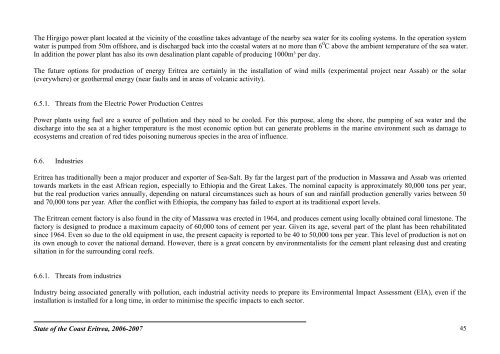Eritrea's Coastal Marine and Island Biodiversity Conservation Project
Eritrea's Coastal Marine and Island Biodiversity Conservation Project
Eritrea's Coastal Marine and Island Biodiversity Conservation Project
You also want an ePaper? Increase the reach of your titles
YUMPU automatically turns print PDFs into web optimized ePapers that Google loves.
The Hirgigo power plant located at the vicinity of the coastline takes advantage of the nearby sea water for its cooling systems. In the operation system<br />
water is pumped from 50m offshore, <strong>and</strong> is discharged back into the coastal waters at no more than 6 0 C above the ambient temperature of the sea water.<br />
In addition the power plant has also its own desalination plant capable of producing 1000m³ per day.<br />
The future options for production of energy Eritrea are certainly in the installation of wind mills (experimental project near Assab) or the solar<br />
(everywhere) or geothermal energy (near faults <strong>and</strong> in areas of volcanic activity).<br />
6.5.1. Threats from the Electric Power Production Centres<br />
Power plants using fuel are a source of pollution <strong>and</strong> they need to be cooled. For this purpose, along the shore, the pumping of sea water <strong>and</strong> the<br />
discharge into the sea at a higher temperature is the most economic option but can generate problems in the marine environment such as damage to<br />
ecosystems <strong>and</strong> creation of red tides poisoning numerous species in the area of influence.<br />
6.6. Industries<br />
Eritrea has traditionally been a major producer <strong>and</strong> exporter of Sea-Salt. By far the largest part of the production in Massawa <strong>and</strong> Assab was oriented<br />
towards markets in the east African region, especially to Ethiopia <strong>and</strong> the Great Lakes. The nominal capacity is approximately 80,000 tons per year,<br />
but the real production varies annually, depending on natural circumstances such as hours of sun <strong>and</strong> rainfall production generally varies between 50<br />
<strong>and</strong> 70,000 tons per year. After the conflict with Ethiopia, the company has failed to export at its traditional export levels.<br />
The Eritrean cement factory is also found in the city of Massawa was erected in 1964, <strong>and</strong> produces cement using locally obtained coral limestone. The<br />
factory is designed to produce a maximum capacity of 60,000 tons of cement per year. Given its age, several part of the plant has been rehabilitated<br />
since 1964. Even so due to the old equipment in use, the present capacity is reported to be 40 to 50,000 tons per year. This level of production is not on<br />
its own enough to cover the national dem<strong>and</strong>. However, there is a great concern by environmentalists for the cement plant releasing dust <strong>and</strong> creating<br />
siltation in for the surrounding coral reefs.<br />
6.6.1. Threats from industries<br />
Industry being associated generally with pollution, each industrial activity needs to prepare its Environmental Impact Assessment (EIA), even if the<br />
installation is installed for a long time, in order to minimise the specific impacts to each sector.<br />
State of the Coast Eritrea, 2006-2007 45


